
Hospitals with pharmacies require alarms beyond those typically supplied by the security industry. Hospitals are responsible for human life so therefore alarms should include life-threatening conditions caused by equipment or services malfunction.
Financial losses can be high when problems are not rectified timeously especially when the storage of pharmaceutical products are involved.
Many faults or alarms are life threatening and demand immediate attention.
The biggest risk with supplying a quick level of response to a problem or disaster is personnel. A single point of failure, such as reception or the security area, may fail to notify personnel on a timely basis, or they were unaware of the severity of the problem and did not know whom to contact for a particular alarm event.
Hospital alarm panels (lamps and buzzers only)
Often a hospital has a main alarm panel situated at reception. There is a high element of staff rotation between the day staff and the night staff, often, new staff members are not trained properly and are not sure whom to call if an alarm is activated. They are not trained to differentiate between a critical or minor alarm, and often do not know who the problem should be escalated to if it is not resolved. Because of this, on more than one occasion, Securlogic has seen staff 'tape up' the alarm accept button to stop the audible alarm from repeating, as they cannot resolve the issue, and the alarm has become a nuisance.
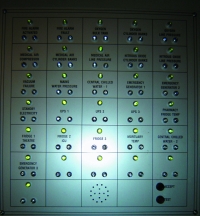
Alarms need to be managed, repeated when necessary and most importantly escalated when they are not resolved.
If the main oxygen tank at a hospital facility should fail, there may be only a matter of 20-40 minutes of standby oxygen available. If this problem is not brought to the correct personnel's attention with immediate effect then the oxygen supply will fail with patients on the operating table. Once again Securlogic has seen these failures and once again it has been caused by human error. The wrong valve switched off or a main valve has not been turned back on after a tank fill or maintenance.
Pharmacy fridges
Other areas that require alarming but are often neglected are the pharmacy areas where pharmaceutical products are stored. The South African pharmacy council requires that pharmaceutical products are stored between 2-8°. The council requires that temperatures are taken twice a day and logged. When these logs are examined they will often show a clean bill of health week after week, when in reality this is far from the truth. Many pharmacies are using domestic fridges designed to keep your milk and margarine cold. These fridges are almost impossible to keep between the prescribed temperature limits due to their design. The worst design being a fridge/freezer combo with the freezer located at the bottom.
Domestic fridges were not designed to store pharmaceutical products; however using domestic fridges to store pharmaceutical products is common practice in South Africa. The frightening truth is that many fridge designs should not be used to store pharmaceuticals.
Most fridge temperature logging processes rely on a thermometer in the fridge, placed at the discretion of the pharmacy manager or staff member. Temperatures are normally taken twice a day while the fridge is being continually opened. Often no records are kept of the temperature during the night or on weekends, and rarely is the thermometer moved to a new fridge location to monitor the temperature at the top and the bottom of the fridge.
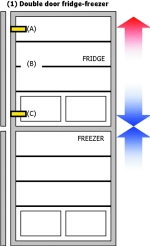
Wisdom states that hot air rises, and cold air drops, therefore cold air settles at the bottom of the fridge and hot air settles at the top of the fridge. The problem with domestic fridges is that there are no fans inside to stir the air and keep a constant temperature; only when the door is opened does the air inside the fridge move with an influx of new warm air.
There are temperature differences between the top and bottom of any fridge. Securlogic has seen temperatures of 7° at the top and -1° at the bottom. This could be a life-threatening problem, as products such as insulin should never be frozen. What if this insulin is given to a patient!
Pharmacy fridges should be fitted with a temperature probe and display that will send an alarm if the fridge goes above 8° or below 2° for longer than 30 minutes.
In an ideal situation, only industrial fridges with fans that circulate the air should be utilised.
Domestic fridges used to store pharmaceutical products
The following two diagrams show two days in the life of a domestic fridge located in the pharmacy area of a neo-natal ward within a hospital.
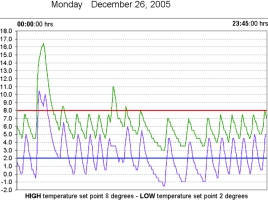
Green is the top of the fridge - pink is the bottom of the fridge. The two lines indicate where the temperature should be maintained. As you can see it is a difficult if not almost impossible task to keep the fridge temperature between 2-8°.
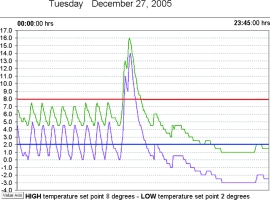
It then seems the fridge went very warm. The personnel then turned the fridge to FULL and ended up freezing the stored products. Once again human error causes the problem and no alarm was sent warning hospital staff of this critical problem.
Other critical services that should be alarmed
Hospitals alarms should be seen to cover all aspects of the hospitals operations from security events, fire alarm activations to critical services responsible for patient care, and the day-to-day running of the hospital facility.
Hospital alarms should include:
Central Chilled Water OUT of Temperature
Emergency Generator FAULT
FIRE ALARM ACTIVATED
Fire Alarm FAULT Condition
Pharmacy Fridge 1 OUT of Temperature
Pharmacy Fridge 2 OUT of Temperature
Mains Water Pressure FAILURE
Medical Air Compressor FAILURE
Medical Air Cylinder Bank FAILURE
Medical Air Line Pressure FAILURE
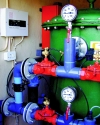
Mortuary OUT of Temperature
Nitrous Oxide Cylinder Bank FAILURE
Nitrous Oxide Line Pressure FAILURE
Oxygen Bulk Tank FAILURE
Oxygen Cylinder Bank FAILURE
Oxygen Line Pressure FAILURE
Pharmacy Fridge OUT of Temperature
Standby Electricity FAILURE
System SMS Test button
UPS FAULT
Vacuum FAILURE
Sprinkler pump house facilities
Water pressure
Diesel fuel tank levels
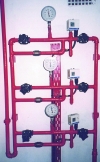
Modern technology in the hospital alarm process
Securlogic has found a practical way to manage the hospital facilities alarms.
Allow the alarms to be displayed at an alarm panel situated at the reception area, but back it up with a cellular phone system.
Critical alarms are sent to the required personnel's cellular phones, and if required displayed on an offsite 24/7 monitoring facility control room.
Certain alarms are only transmitted to personnel's cellular phone after a delay period to allow onsite staff to rectify the problem.
Certain alarms are automatically repeated until the problem is rectified.
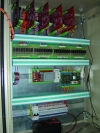
For more information contact Paul Nagle, Securlogic, 011 435 4446, or visit www.securlogic.co.za

© Technews Publishing (Pty) Ltd. | All Rights Reserved.